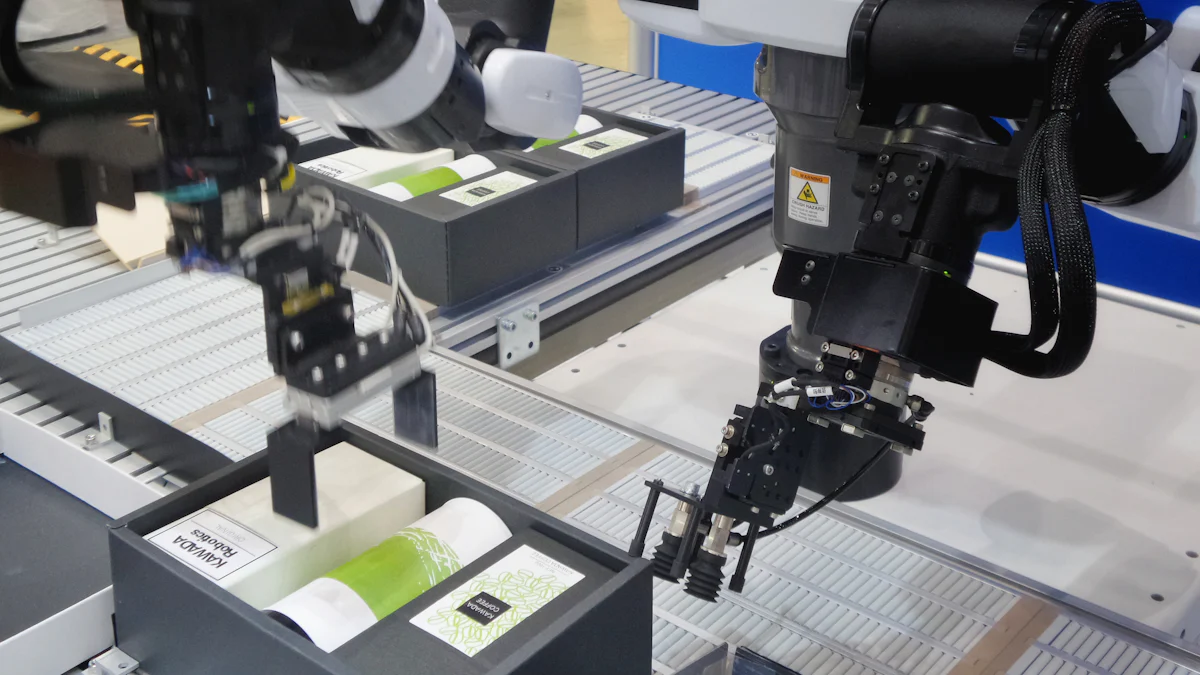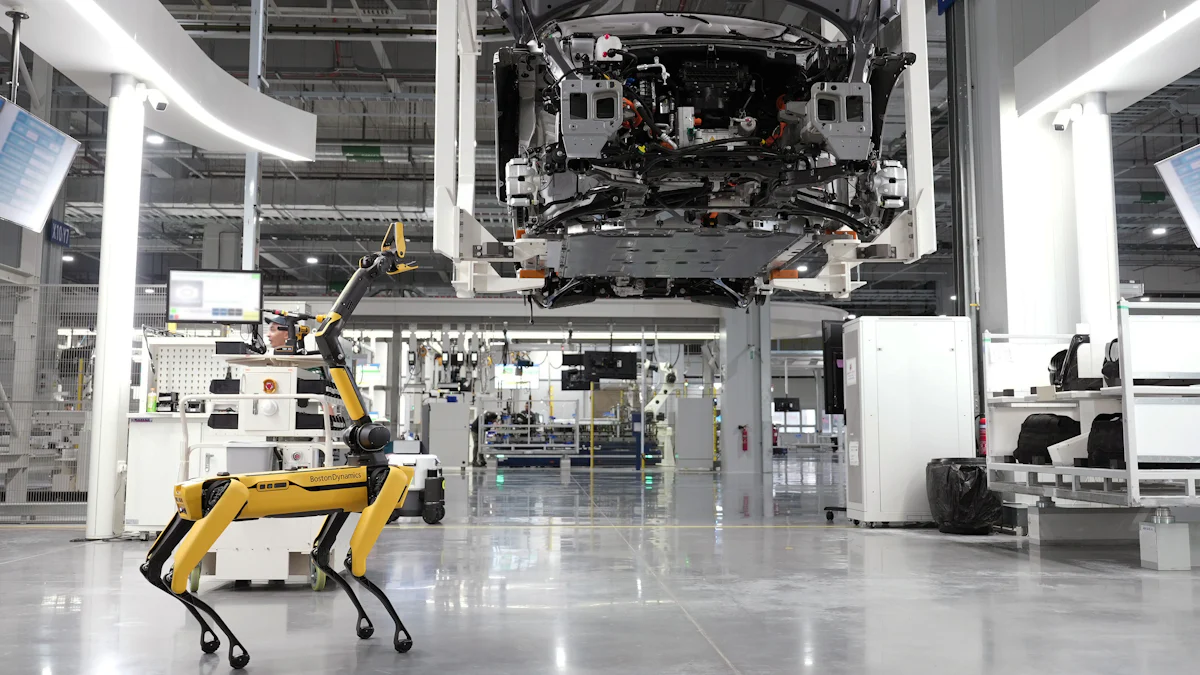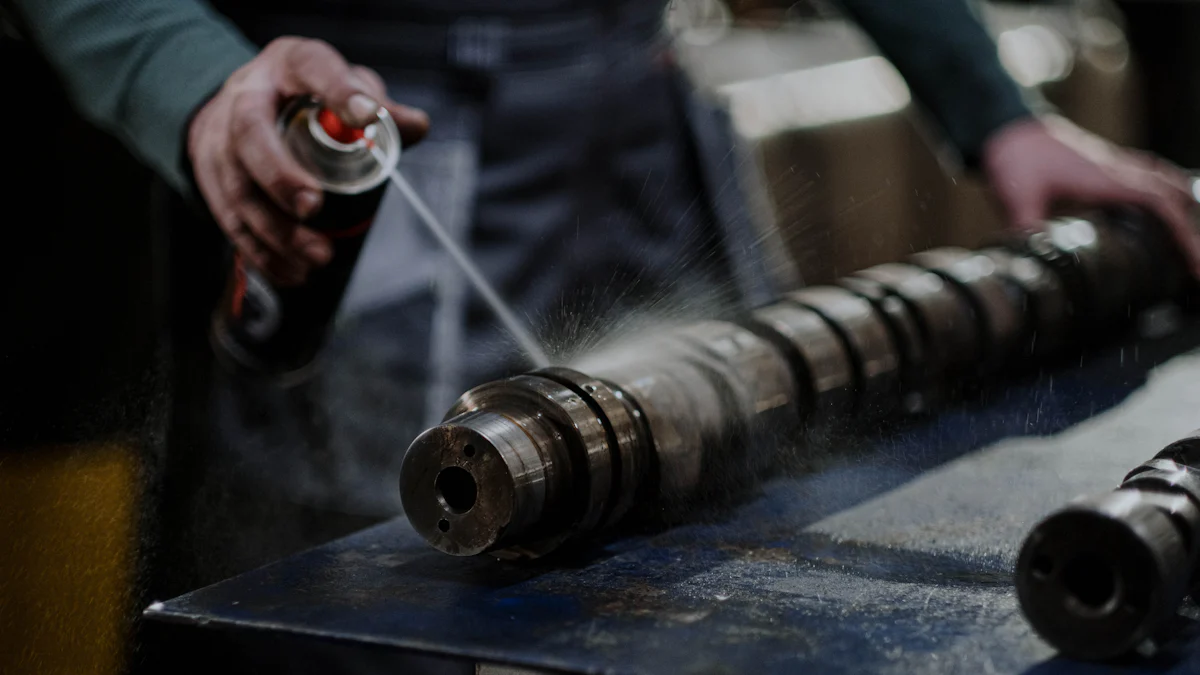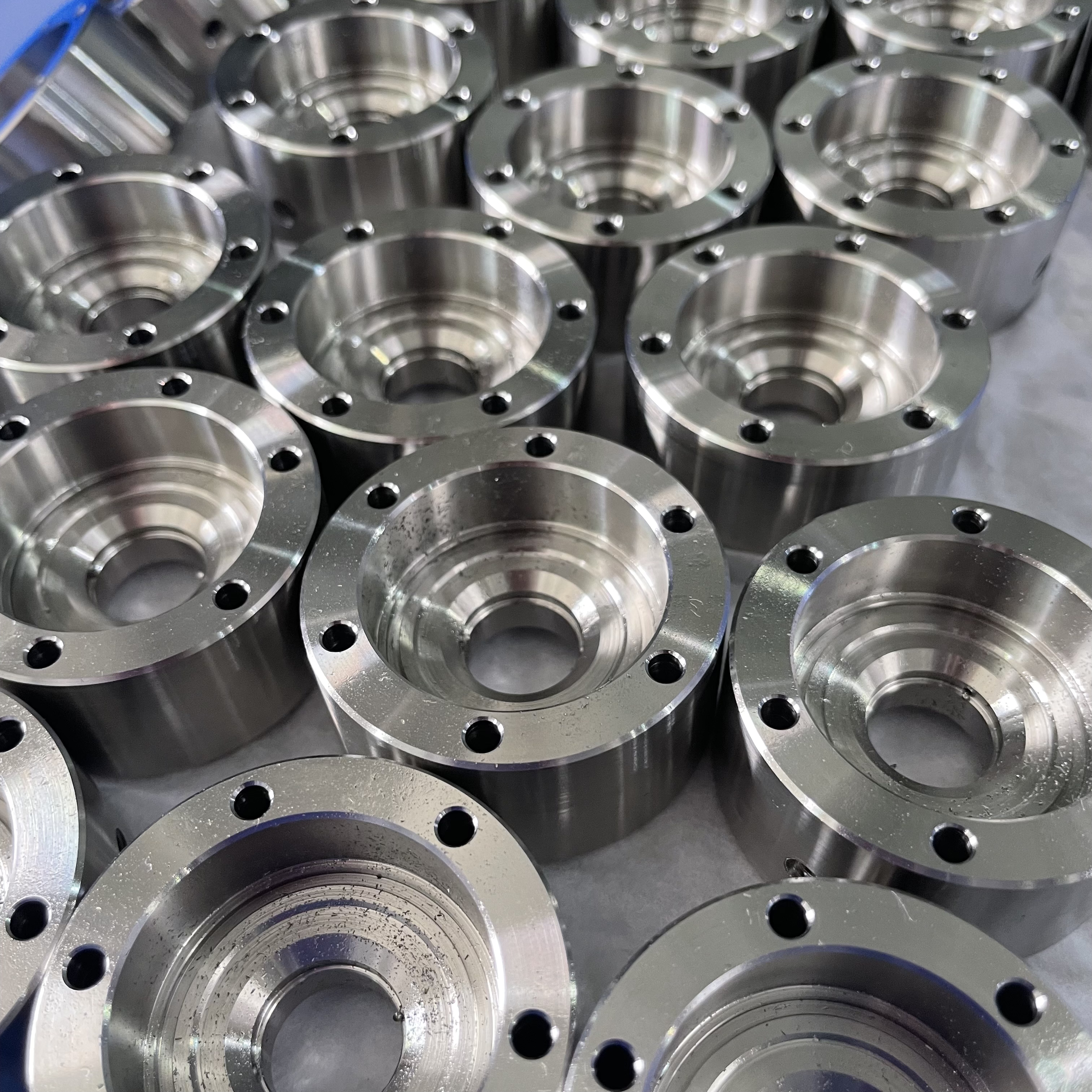CNC Machining Materials for Cutting-Edge Robotics

When building cutting-edge robotics, material selection plays a critical role in performance. CNC machining offers precision and flexibility, making it ideal for crafting robotic components. Materials like aluminum, titanium, and stainless steel provide exceptional strength and durability. Plastics such as PEEK and Delrin reduce weight while maintaining structural integrity. Carbon fiber-reinforced polymers excel in lightweight applications, enhancing efficiency. For example, aluminum alloys are widely used for their strength-to-weight ratio, while injection-molded thermoplastics keep robots light without compromising functionality. CNC machines ensure these materials meet exact specifications, enabling you to create reliable and efficient robotic systems.
Key Takeaways
Picking the right material is important for robots to work well. Use light materials like aluminum and plastics to make robots faster and save energy.
CNC machining helps make parts exact and the same every time. It can create tricky shapes and matching pieces, which robots need to work properly.
Strong and rust-proof materials are important. Metals like stainless steel and titanium handle tough conditions, and plastics like PEEK resist chemicals.
Think about how easy it is to shape materials. Materials like aluminum and Delrin are simple to work with, saving time and money, which is great for robots.
Keep up with new ideas. Special metals and eco-friendly materials are improving CNC machining for robots, making them better and greener.
The Role of CNC Machining in Robotics

Why CNC Machining is Essential for Robotics
CNC machining plays a pivotal role in robotics by delivering unmatched precision and versatility. You can rely on CNC machines to achieve dimensional accuracy between 0.02 to 0.05 mm, which is crucial for creating components that fit perfectly in robotic systems. This level of precision ensures that robot arms and other moving parts operate smoothly without unnecessary friction or wear. CNC robotics also excels in consistency, producing identical parts repeatedly, which is vital for industrial automation and collaborative robots.
Unlike traditional manufacturing methods, CNC machines offer greater flexibility. They adapt to various tasks, allowing you to create complex designs for robotic machining. For example, CNC lathes can shape components with high symmetry, ensuring balance and stability in automated robots. Additionally, CNC robotics provides value for money by handling multiple operations on a single workpiece, reducing production time and costs. These advantages make CNC machining indispensable for the future of robotics.
Importance of Material Selection in Robotic Applications
Choosing the right material for CNC machining directly impacts the performance and longevity of your robotic systems. Materials like aluminum alloys, used in Boston Dynamics’ SpotMini, demonstrate how careful selection enhances durability and mobility. Aluminum’s high strength-to-weight ratio makes it ideal for lightweight yet robust designs. For friction-prone areas, materials like Teflon-infused hard-anodized aluminum minimize wear and heat generation, ensuring smooth operation.
Poor material selection can lead to inefficiencies or even failure in robotic applications. For instance, using heavy or brittle materials may compromise the agility of collaborative robots. On the other hand, lightweight plastics such as PEEK and Delrin reduce weight without sacrificing strength, making them perfect for industrial automation. By prioritizing material properties like machinability, corrosion resistance, and strength, you can optimize your robotic systems for diverse applications.
Key Material Categories for CNC Robotics
Metals
Aluminum
Aluminum is one of the most commonly used metals in CNC machining for robotics. Its high strength-to-weight ratio makes it ideal for lightweight robotic components. You can use aluminum alloys to create durable parts without adding unnecessary weight. This property is especially useful in collaborative robots, where agility and efficiency are critical. Aluminum also offers excellent machinability, allowing CNC machines to achieve high dimensional accuracy and smooth finishes. Additionally, its corrosion resistance ensures long-lasting performance in various environments.
Titanium
Titanium stands out for its exceptional strength and low density. It is perfect for robotic machining applications requiring high precision and durability. You can rely on titanium for components exposed to extreme conditions, such as high temperatures or corrosive environments. Despite being more challenging to machine than aluminum, CNC precision machining ensures that titanium parts meet exact specifications. This metal is often used in automated robots for aerospace and medical robotics, where reliability is non-negotiable.
Stainless Steel
Stainless steel offers unmatched durability and corrosion resistance. It is a go-to material for manufacturing parts that must withstand heavy loads or harsh conditions. You can use stainless steel for robot arms or components in the automation of material handling. Its strength and wear resistance make it suitable for high-stress applications. Although it is heavier than aluminum or titanium, CNC machines can still process stainless steel with high precision, ensuring consistent quality.
Plastics
PEEK
PEEK (Polyether Ether Ketone) is a high-performance plastic known for its strength and thermal stability. It is lightweight yet strong, making it ideal for robotics requiring weight reduction without compromising durability. PEEK resists chemicals and high temperatures, making it suitable for demanding environments. CNC machining allows you to create high-quality machine parts from PEEK with tight tolerances and smooth finishes. This plastic is often used in collaborative robots for its ability to handle cyclic loading.
Delrin
Delrin, or acetal, is another popular plastic in robotic applications. It is lightweight and offers excellent machinability, enabling CNC machines to produce high-precision parts. Delrin’s low coefficient of friction makes it ideal for moving parts, such as gears or sliding mechanisms. However, it has limitations, such as lower abrasion and temperature resistance compared to other materials. Despite this, Delrin remains a cost-effective choice for many robotics projects.
Advantage/Disadvantage | Description |
|---|---|
Lightweight | Delrin is lighter than many other engineering plastics, making it ideal for weight-critical applications. |
High Strength | Offers excellent strength and stiffness for structural applications requiring high performance. |
Machinability | Easy to machine for precision CNC parts with tight tolerances and smooth finishes. |
Low Coefficient of Friction | Suitable for sliding or moving parts, reducing wear and improving efficiency. |
High Stress and Strain Capability | Withstands high stress and strain without cracking, ideal for cyclic loading components. |
Moisture Resistance | Low moisture absorption ensures dimensional stability in humid environments. |
Not Abrasion Resistant | Less resistant to abrasion compared to Nylon, limiting use in high-wear applications. |
Low Temperature Resistance | Lower temperature resistance compared to Nylon, restricting use in high-temperature settings. |
Composites
Carbon Fiber-Reinforced Polymers
Carbon fiber-reinforced polymers (CFRPs) combine lightweight properties with exceptional strength. These composites are significantly lighter than metals, making them ideal for robotics where weight reduction is essential. You can use CFRPs to create robot arms or structural components that require high stiffness. CNC robotics ensures precise machining of CFRPs, enabling you to achieve high-quality machine parts. These materials are widely used in industries like aerospace and automotive, where performance and efficiency are priorities.
Glass Fiber-Reinforced Polymers
Glass fiber-reinforced polymers (GFRPs) offer a cost-effective alternative to CFRPs. They provide good strength and durability while being lighter than metals. GFRPs are suitable for applications requiring moderate strength and stiffness. CNC machines can process GFRPs with high precision, ensuring consistent quality. While not as strong as CFRPs, GFRPs remain a versatile choice for many robotic applications.
Factors to Consider When Choosing CNC Machining Materials
Weight and Strength
Weight and strength are critical factors when selecting materials for robotics. Lightweight materials, such as aluminum alloys and carbon fiber-reinforced polymers, reduce the overall mass of robotic systems. This improves energy efficiency and agility, especially in collaborative robots. For example, aluminum offers an excellent strength-to-weight ratio, making it ideal for robot arms and other moving parts. On the other hand, high-strength materials like titanium and stainless steel provide the durability needed for automated robots operating in demanding environments. Balancing weight and strength ensures your robotic components perform efficiently without compromising structural integrity.
Durability and Corrosion Resistance
Durability and corrosion resistance determine how well a material withstands wear and environmental factors. Stainless steel excels in harsh conditions due to its high tensile strength and rust resistance, making it suitable for industrial automation. Aluminum alloys also offer moderate corrosion resistance, while Teflon-infused hard-anodized aluminum reduces wear and ensures smooth operation. Plastics like PEEK and Delrin resist chemical exposure but may not match the durability of metals. The table below highlights the durability and corrosion resistance of common CNC machining materials:
Material Type | Durability Characteristics | Corrosion Resistance |
|---|---|---|
Stainless Steel | High tensile strength, excellent rust resistance | Maintains strength in chemically reactive environments |
Aluminum Alloy | Good strength-to-weight ratio | Moderate corrosion resistance |
Injection Moulded Thermoplastic | Lightweight, economical | Varies, generally lower than metals |
Teflon-Infused Hard-Anodized Aluminum | Reduces wear and maintains smooth operation | Good resistance to chemical corrosion |
Steel | Strong and durable, but heavy | Prone to rust without protective coatings |
Plastic Composites | Economical and lightweight | Generally less strong under harsh conditions |
Machinability and Precision
Machinability and precision impact the efficiency of CNC machining processes. Materials like aluminum and Delrin are easy to machine, allowing CNC machines to achieve high precision and smooth finishes. However, machining high-strength materials like titanium or stainless steel presents challenges. These include accelerated tool wear, heat management issues, and difficulties in achieving tight tolerances. For example, poor thermal conductivity in titanium can cause heat to concentrate at the cutting zone, potentially damaging tools and workpieces. To overcome these challenges, you must select appropriate cutting tools and optimize machining paths. High precision is essential for robotics, ensuring components fit seamlessly and function reliably in automated systems.
Cost and Availability
When selecting materials for CNC machining in robotics, cost and availability play a significant role. The price of materials often depends on their properties. For example, metals like stainless steel and titanium are more expensive because of their strength and durability. Softer metals, such as aluminum, and plastics, like Delrin, are usually more affordable. These differences allow you to balance performance and budget based on your project’s needs.
Availability also affects material costs. Some materials, like carbon fiber-reinforced polymers, may have limited supply, leading to higher prices. On the other hand, widely available materials, such as aluminum alloys, tend to be more cost-effective. Market demand and regional supply chains can further influence pricing. For instance, if a material is in high demand for industrial automation or aerospace applications, its cost may rise. Staying informed about market trends helps you plan your budget effectively.
CNC machines can process a wide range of materials, but the machining process itself can impact costs. Materials that are harder to machine, like titanium, require specialized tools and longer machining times. This increases production expenses. In contrast, materials with high machinability, such as aluminum and Delrin, reduce machining time and tool wear, making them more economical for CNC robotics projects.
When designing collaborative robots or automated robots, you must consider both material cost and availability. Lightweight materials, like aluminum and PEEK, may cost more upfront but improve energy efficiency and reduce long-term expenses. For heavy-duty tasks, stainless steel offers durability but comes with a higher price tag. By carefully evaluating these factors, you can optimize your material choices for both performance and budget.
Emerging Trends in CNC Machining Materials for Robotics

Advanced Alloys
Advanced alloys are transforming the way you approach robotics. These materials combine the best properties of metals, such as strength and corrosion resistance, with enhanced machinability. For instance, aluminum-lithium alloys offer even greater strength-to-weight ratios than traditional aluminum, making them ideal for robot arms and end effectors. These alloys reduce weight while maintaining structural integrity, improving the energy efficiency of automated robots. Titanium-based alloys, like Ti-6Al-4V, are also gaining traction. They provide exceptional durability and withstand extreme conditions, making them suitable for aerospace and medical robotics. CNC machines excel at processing these advanced alloys, ensuring precise and reliable components for your robotic systems.
Sustainable and Eco-Friendly Materials
Sustainability is becoming a priority in CNC machining for robotics. By recycling metal scraps, you conserve raw materials and reduce energy consumption compared to processing new materials. Energy-efficient machines further minimize carbon footprints, while optimized machining processes cut down on waste. Manufacturers are also shifting toward biodegradable and eco-friendly materials instead of traditional options like ABS and PVC. This change aligns with global sustainability goals and meets the growing demand for environmentally conscious products. By integrating CNC machines with sustainable practices, you can create robotic components that not only perform well but also contribute to a greener future.
Innovations in Composite Materials
Composite materials are evolving rapidly, offering exciting possibilities for robotics. These materials improve strength and durability, making them suitable for high-stress components like end-of-arm tooling. Weight reduction is another key advantage. For example, lighter body panels enhance the agility and energy efficiency of collaborative robots. Some composites now integrate sensors, enabling environmental awareness and structural health monitoring. This multifunctionality enhances the performance of CNC robotics. Additionally, reduced weight leads to longer battery life and even energy harvesting capabilities. CNC machines allow you to precisely shape these innovative composites, ensuring they meet the exacting demands of modern automation.
Selecting the right materials for CNC machining is crucial for building efficient and durable robotic systems. Material choice directly affects performance, as seen in Boston Dynamics’ SpotMini. Its aluminum alloy frame enhances durability while keeping the robot lightweight. Injection-molded thermoplastics further reduce weight without compromising functionality. For friction-prone areas, Teflon-infused hard-anodized aluminum minimizes wear and heat generation. These examples highlight how thoughtful material selection improves energy efficiency, agility, and longevity. By leveraging CNC machines, you can craft precise components tailored to your robotics needs, ensuring optimal performance and reliability.
FAQ
What is the best material for lightweight robotic components?
Aluminum is an excellent choice for lightweight robotic components. Its high strength-to-weight ratio ensures durability without adding unnecessary mass. This makes it ideal for applications requiring agility and energy efficiency.
Can CNC machines handle composite materials like carbon fiber?
Yes, CNC machines can process carbon fiber-reinforced polymers with precision. These materials require specialized tools to avoid fraying or delamination. CNC machining ensures smooth finishes and tight tolerances for high-performance robotic parts.
Why is machinability important in material selection?
Machinability affects production time, cost, and precision. Materials like aluminum and Delrin are easier to machine, reducing tool wear and ensuring accurate results. This makes them cost-effective and reliable for CNC robotics projects.
Are plastics like PEEK durable enough for robotics?
PEEK is highly durable and resists chemicals, heat, and wear. It works well in demanding environments, making it suitable for robotic components that require strength and thermal stability.
How do material costs impact CNC robotics projects?
Material costs influence your budget and design choices. High-performance materials like titanium or CFRPs are expensive but offer superior properties. Affordable options like aluminum or Delrin balance performance and cost for many applications.
See Also
Grasping Material Needs for CNC Precision Machining Success
Achieving Expertise in CNC Machining for Precision Components
Streamlined CNC Machining Solutions for High-Quality Production
Enhancing Production Standards Using CNC Precision Machining Tools
Delving into CNC Machining: Precision Fabrication and Cutting
About US
Follow Us
Your prototype holds unparalleled significance, and we deeply value its uniqueness. Collaborating with you during the preparation phase for running your prototype or parts is a commitment we gladly embrace. Whether it's a single part or a complex assembly, we are dedicated to selecting the optimal tools and pathways to bring your envisioned product to life.
At Precision Fab CNC Machining, we specialize in producing parts for prototypes, short runs, and high-volume production. Our prototyping machine capabilities extend across metal, plastic, and wood machining, with welding fabrication services available to complement and finalize your prototype if required.
Address
Address: Room320 10F, Building A,Nanshan international building, Dayawan District, Huizhou, Guangdong, 516001 China
Contacts
billy@timaycnc.com

